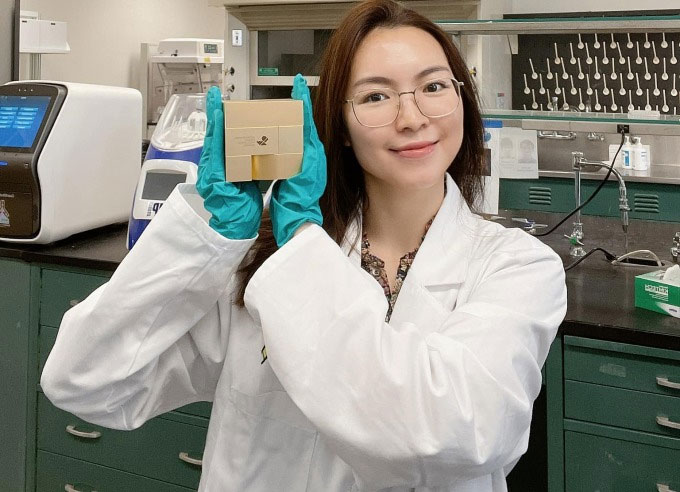9x Vietnamese inventor makes fabric from seafood shells
A young Vietnamese-born inventor, Uyen Tran, found a way to reuse shrimp shell by-products and combine coffee grounds into a substitute for leather.
Chloe Uyen Tran (29 years old) is planning with investors and suppliers to bring the imitation leather fabric she named TomTex back to her hometown.
Uyen Tran was born in Da Nang, lived and worked in the US for 10 years. She graduated with a master's degree in fashion design from Parsons The New School of Design, the largest university of art and design in New York, USA.
The idea of TomTex material rekindled from familiar things that reminded Uyen of her hometown. "I grew up wearing second-hand clothes, second-hand clothes from Western countries," she said. The pollution at the waste dumps of garment products made from polyester and synthetic fabrics and the process of working with real leather and artificial leather made Uyen worried. "This type of material will not decompose for 500 years when it is thrown out, causing a serious impact on the environment," she said.

Chloe Uyen Tran, founder of TomTex.
Desperate to find an eco-friendly material, she decided to pursue a master's degree in biomaterials at Parsons College of Design. After a year of tinkering, the first version of the material TomTex was born.
The Vietnamese designer in New York said that the biological material ShrimpTex comes from two main sources, chitin, which is derived from seafood shells and mycelium. They first extracted chitosan and then combined it with a biological binder, mixing it with a natural colorant like coffee. This mixture is poured into molds, dried at room temperature for about 2-3 days and can be used. The process does not require heat thus saving energy and reducing carbon emissions.
The resulting compound can be customized to resemble leather, rubber or plastic by adjusting the proportions and manufacturing methods.

Finished leather products are made from seafood shells and coffee grounds.
The special feature of TomTex is that it is made from 100% ingredients of biological origin without having to go through the tanning process. This process is used to treat animal skins, making the material more durable and difficult to decompose, but causes environmental degradation due to the use of harmful chemicals. The material is used to make clothes, shoes, bags, accessories, furniture, tools and sports equipment. At the end of its life, the product can be recycled or biodegraded in the natural environment.
Uyen said that finding materials not only comes from the desire to succeed, but also from the social responsibility of her business. "I want to build a business that values people and puts the responsibility of protecting the environment first," she said.
The fabric created by her received awards in the fashion world such as the LVMH Innovation Award (award that supports innovative ideas and initiatives), the CFDA K11 Innovation champion for creative design thinking in the fashion industry. Sustainable fashion system from the American Fashion Association (CFDA).

TomTex's research team in the lab.
ShrimpTex is in the research and development stage, receiving an investment of 1.7 million USD with a company value of 10 million USD. Uyen said that last year was a difficult year for her and many people. "I also struggled to set up a company, but I feel lucky to still receive support and care," she told PV.
Deeming herself to be optimistic, creative and persistent, Uyen shared her desire to contribute to the development of the country's industry in the future.
- Mistakes when eating seafood many people suffer
- Fabric has the ability to pronounce
- Instructions on how to eat seafood without allergy, poisoning
- How long does it take for seafood to be discarded? The doctor's answer will surprise you!
- Why do seafood often cause allergies?
- Waterproof fabric thanks to its ability to drain water
- Identify toxic seafood
- Traveling to the sea, be careful with what kind of specialties?
- Fukushima seafood 're-export' market after nuclear disaster
- Intelligent fabric can detect and protect against harmful gases
- The weather is hot, what kind of fabric is best for hot sun protection?
- Technology time, even fabric can be woven from fiber, led
 'Barefoot engineer' invents a pipeless pump
'Barefoot engineer' invents a pipeless pump Process of handling dead pigs due to disease
Process of handling dead pigs due to disease Radiometer
Radiometer Warp Engine: Technology brings us closer to the speed of light
Warp Engine: Technology brings us closer to the speed of light